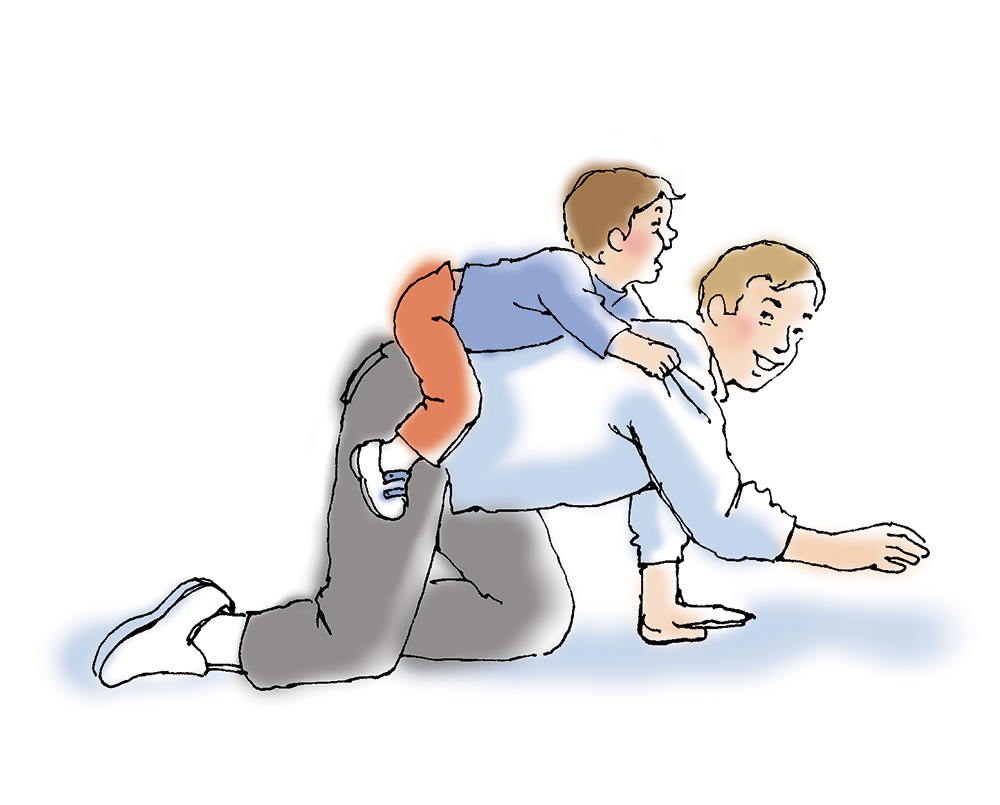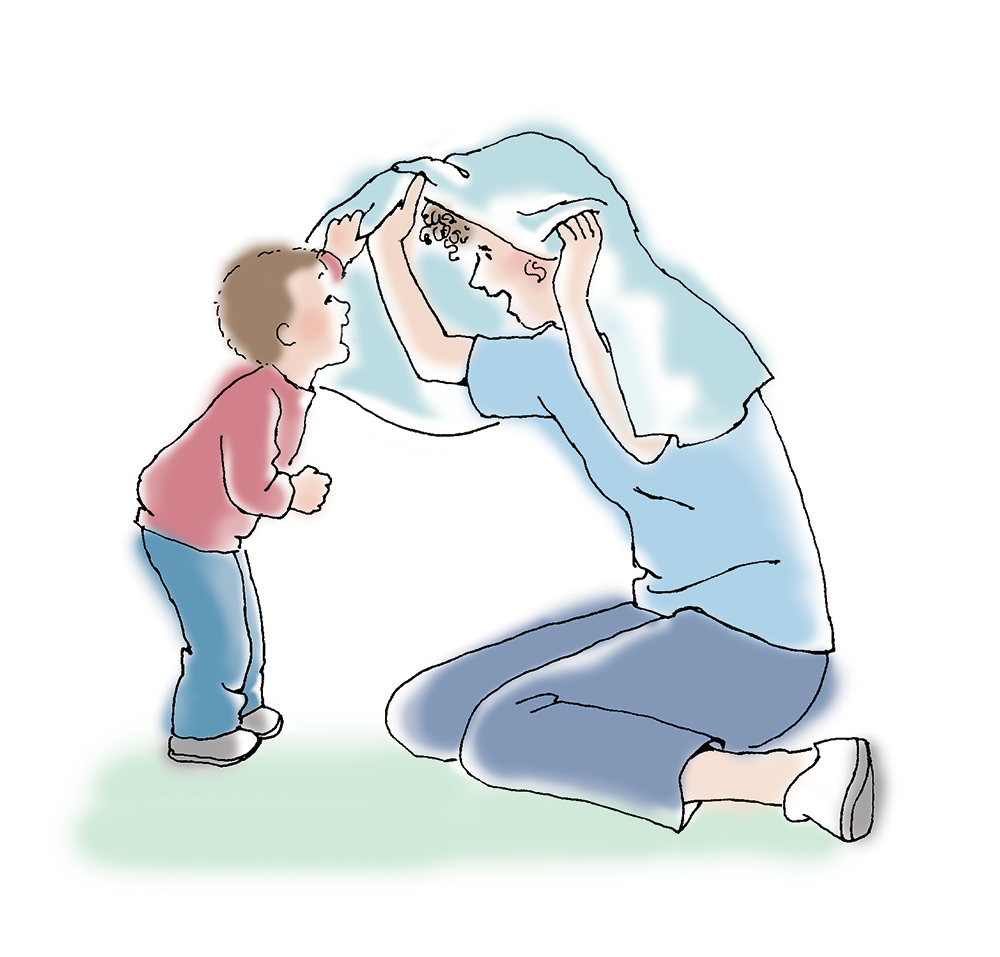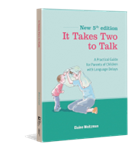You Are Your Child's Best Toy

Did you know that you already have the best toy for language development in your home? You didn’t buy it at a store – actually, it doesn’t cost anything. It’s portable, adaptable, and best of all, it’s tons of fun! Your child loves to play with it, more than any other toy. That’s because your child’s best toy is…YOU!
When you and your child play together without toys, you become the toy. This happens during social games like peek-a-boo, tickles, horsie rides, or chase. We call this type of social play “people games” because these games only involve people, not toys.
What is a people game?

People games are social games played with people, not toys. Here are some examples of familiar people games:
- Tickles
- Peekaboo
- Horsie Rides
- “Ring Around the Rosie”
- Games played on the hands and feet like “This Little Piggy”, “Pat-a-cake”, or “Round and Round the Garden”
- Chase
- Hide and Seek
Many of these games are described in the It Takes Two to Talk® guidebook [1], along with guidance about how to use these games to encourage communication development.
Advantages of people games for language development
People games have many advantages when it comes helping children with delayed language development:
- It’s easier for your child to focus on you – For some children, having to constantly switch their attention back and forth between their parent and a toy is very difficult, and attention that could be spent learning from the parent ends up being focused on the toy. But during people games, your child only has to focus on you, and this makes it easier for him to pay attention to the actions, sounds, and words that you use during the game.
- It’s easier for you to focus on your child – Because it’s just you and your child, it’s easier to notice and respond to his subtle ways of communicating.
A recent study found that parents of children with severe communication delays tend to follow their child’s lead and be more responsive during social play than while playing with a toy [2].

- People games are played the same way each time – This repetition allows you to use the same actions and words over and over again. Because of this, it’s easier for your child to learn these words and actions, and to know how and when to participate in the game.
- Children with delayed language can participate in people games – There are many nonverbal opportunities for your child to participate because people games usually involve actions or movements. If your child uses words, he can participate by saying something when you pause and wait during a predictable moment during the game.
- You can make up your own people game – Sometimes the best people games are the ones parents create for their child based on his interests. For example, for a child who loves jumping, making up a game or song while the child jumps on the bed or a trampoline can be very motivating. When you make up your own game, you can tailor it to your child’s language goals. You can use simple, repetitive words and phrases that are at your child’s language level.
- People games are fun! – These games often revolve around a song your child enjoys or an action your child loves to do (like running or jumping). This makes them a fun context for learning to communicate.
Putting a SPARK in your people games
People games can be so much more than a few tickles and laughs – they can also provide a wonderful opportunity to encourage your child’s communication skills. You can do this by using the SPARK strategy described in the It Takes Two To Talk© guidebook [1]:
Start the same way each time – Name your game and invite your child to play with you by using the name of the game (“Let’s play tickles”). If possible, do an action or gesture when you say the name of the game (e.g., put your hands in the tickling position) to help your child understand your words. Starting the game the same way each time helps your child understand your words and know what to expect.
Plan your child’s turn – Think about a moment in the game when your child can participate in some way. Maybe he can show you he wants more of the game once it ends by moving his body, looking at you, or reaching. Perhaps he could make a sound or use a word. More verbal children might try to say a key phrase during the game (e.g., “I found you!” during Hide and Seek).
Adjust the routine so your child can take a turn – You can adjust the game by pausing at a key moment to let your child participate. Most games have a high point (the most fun part of the game!), like when you fall down during Ring Around the Rosie, or the moment when you tickle your child at the end of “This Little piggy”. Pausing right before the high point builds excitement and encourages your child to participate in order for the game to continue. You can encourage your child to participate further by giving a cue (or hint), like leaning in close, opening your eyes wide with anticipation, using a gesture or action to remind your child what to do, or asking a question (“Do you want more tickles?”).
Repeat the same actions, sounds & words – This repetition helps your child learn what’s coming next, and the words that go along with each part of the game.
Keep the end the same – Let your child know that the game has ended by saying and doing the same thing each time you play. Then your child knows that the game is over. The consistent end of the game also teaches him a way of ending the game himself eventually. Some games have a natural ending (at the end of Ring Around the Rosie everyone says, “We all fall down” and they fall down). If your game doesn’t have a natural ending, you can say something like “No more tickles. We’re all done!”
So put away the toys for a few minutes and let your child play with the BEST toy in your home! And by adding some “SPARK” to your people games, you’ll have a terrific time together while providing your child with new opportunities to communicate.

Discover more ideas for using the SPARK strategy during everyday activities with your child in the It Takes Two to Talk® guidebook.
Similar articles by tag:
